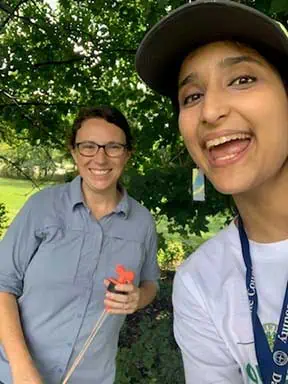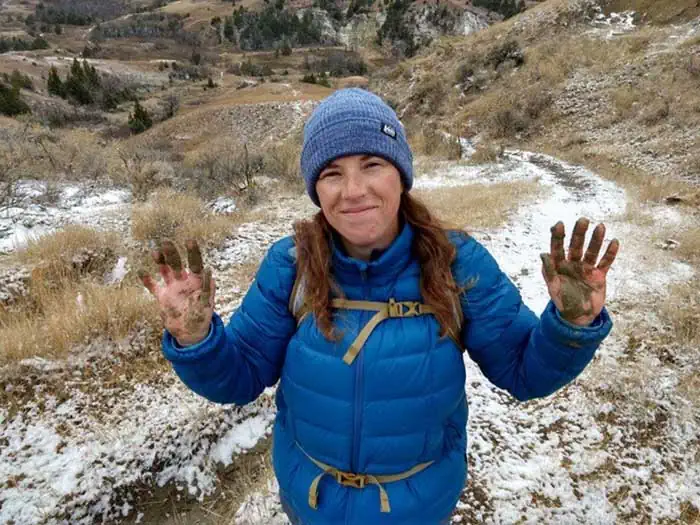

What’s Environmental Consulting?
Jackie Rennebohm stands on a landfill in Madison, Wisconsin, pops open a monitoring well, bails some water, and dumps it on the ground while a cluster of neighbors looks on. They see she had no qualms about coming into contact with the liquid— it’s what a young professional does in a day’s work, she tells them.
“I explain that we strategically place the wells to monitor for contaminants that could leak from the landfill but let them know the site is lined for protection. In 30 years, there’s been no detection of pollutants from the landfill,” Rennebohm says.
She’s upbeat, sincere, and informative; they are interested and feel confident in her explanation of landfill science and engineering. Being a good neighbor is a goal of every landfill.
Gaining trust can go a long way on the job and is something Rennebohm has always prioritized. She figures it’s played a big role in her ability to climb the ropes at SCS Engineers and to offer her clients and project managers what they need—that and her attention to detail and her thirst to keep learning.
Her earliest charge as a new geology graduate seven years ago was logging soils and documenting details for groundwater management. She quickly began learning about different soil types; how to classify them; the features of each that affect their ability to carry contaminants; and how and where those contaminants might migrate.
Moving into new territories

As she’s developed in her career, she’s taken on greater roles and now owns more parts of larger environmental consulting projects.
Beyond monitoring groundwater at landfills and water in nearby private wells and reporting her findings to regulators, the ambitious scientist dedicates her time to the remediation of real estate properties. She begins with Phase 1 Environmental Site Assessments (ESAs), scrutinizing topographic maps, soil maps, investigation reports from local regulatory agencies, and other historical data to determine if a property likely has hazardous contaminants. Depending on her findings, she digs deeper, conducting a Phase 2 ESA by testing soil and groundwater to confirm if the site is contaminated.
“I like doing Phase 1 Assessments, especially because they really challenge you to be meticulous in identifying issues that could be material concerns. You can’t miss a single detail, or an issue could come up later that could cost time and money for our clients.”
“Developers make huge investments, and if it were mine, I’d want to know I hired someone who will be as conclusive as possible.”
If Rennebohm’s due diligence confirms contamination to resolve, she transitions to remediation planning mode.
“That’s when we move from investigator to developing a sound strategy to protect the health of the neighbors, the environment, and the property developer’s bottom line,” she says.
The plan may entail removing or cleaning impacted soil and, in some cases, installing a vapor barrier to prevent volatile gases from migrating into buildings. The solutions are unique to each site, ensuring the groundwater stays pristine and any new structures are in healthy environments.
She’s gotten good at getting to the route of a problem and coming up with an action plan leveraging conceptual site models. She relies on these models to form a hypothesis, gather data, and then does more research to build on her initial findings. With that comes more knowledge to piece the puzzle together ultimately. “I might start by looking for potential groundwater contaminants, then work to determine where those contaminants would likely move downgradient. Once I collect enough preliminary data about the subsurface, I can form a scientific hypothesis. The deeper I go, the closer I get to having answers to inform possible next steps,” she says.
It takes a keen eye
One of her college professors would say that the best research geologist sees the most rocks. In her eyes, it’s the same principle as being the best environmental consultant.
“It’s about being out there and physically looking at soil sample after sample and analyzing groundwater in multiple scenarios. You get a solid understanding of site conditions across different parts of the state, weighing many variables. The more you observe, the more you learn, and you apply that learning in the field,” she says.
Expanding her knowledge and showing what she can do with it has been key to advancing in her career – and it ties into that priority she broached earlier: gaining trust.
She says you must show your project managers you are ready to work on more environmental consulting tasks.
“It’s been important to my supervisors to see that I understand the conceptual site model to know where we are starting with a project and where we need to go to reach the end goal. As important is offering ideas for how to get there instead of waiting to be told what to do. It’s rewarding that my team trusts my judgment.”
From researcher to environmental consultant
Rennebohm’s found her sweet spot in environmental consulting.
“In school, I really liked geological research, learning about life, time, processes, and change. Research is important, though I also enjoy working in the field to help make meaningful changes. It’s gratifying to see blighted properties transform into valuable assets with purpose. Or to be part of a team drawing up a proposal and winning it. You own your work, and it’s a proud feeling,” she says.
She’s left to run with more these days. She serves as the primary author and reviewer of large environmental reports when she formerly contributed short summaries. And she spends more time with clients than in the days when she’d make a quick call from the field to brief them on one point in the big picture. Now Rennebohm’s their point of contact for scheduling requests, coordinating work, writing proposals, and preparing quotes.

What’s ahead
“I see myself doing a lot more on the client relations side. I like interacting with them and coordinating the work needed to meet their goals,” she says.
And she wants to venture further into another territory: business development, a space she hadn’t envisioned herself entering a few years ago.
“While I have a customer service backbone, I thought, I’m a scientist, not a salesperson. But I think differently now that I’ve grown at SCS.”
She’s networking at business conferences and meetings, explaining to residents the important roles of landfills and telling developers how consultants who do environmental site assessments can help them protect their investments.
“I’ve come to realize business development isn’t exactly selling. It’s listening, then working with people. It’s providing clients with the insight to reach their goals,” she says.
Environmental consulting builds mental dexterity. She believes that branching out into more roles and working with more people helps build character.
“I’m becoming more open-minded and breaking out of my shell, and I can contribute more to the big picture. In all I do, I’m working to protect people and the environment.”
Contact SCS Engineers to join our professionals with rewarding careers. in environmental consulting.